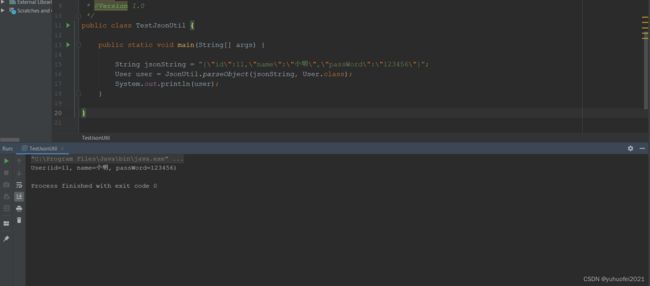利用Jackson封装常用的JsonUtil工具类
在实际开发中,我们对于 JSON 数据的处理,通常有这么几个第三方工具包可以使用:
- gson:谷歌的
- fastjson:阿里巴巴的
- jackson:美国FasterXML公司的,Spring框架默认用的
由于以前一直用习惯了阿里的 fastjson,最近突然改为 jackson ,不是太习惯,所以手写一个工具类,应付一下工作中常用的一些方法。
1. 引入依赖包
在 pom.xml 文件中加入以下依赖
<dependency>
<groupId>com.fasterxml.jackson.coregroupId>
<artifactId>jackson-databindartifactId>
<version>2.14.2version>
dependency>
2. 编写 JsonUtil 工具类
package com.yuhuofei.utils;
import com.fasterxml.jackson.annotation.JsonInclude;
import com.fasterxml.jackson.core.JsonProcessingException;
import com.fasterxml.jackson.core.type.TypeReference;
import com.fasterxml.jackson.databind.DeserializationFeature;
import com.fasterxml.jackson.databind.JsonNode;
import com.fasterxml.jackson.databind.ObjectMapper;
import com.fasterxml.jackson.databind.SerializationFeature;
import com.fasterxml.jackson.databind.node.ArrayNode;
import com.fasterxml.jackson.databind.node.ObjectNode;
import lombok.extern.slf4j.Slf4j;
import java.io.File;
import java.io.IOException;
import java.text.SimpleDateFormat;
/**
* @Description 由于习惯了用fastjson处理JSON数据,突然改成用jackson,有些不适应,所以打算用jackson封装出类似fastjson里的方法进行使用
* @ClassName JsonUtil
* @Author yuhuofei
* @Date 2023/8/19 14:36
* @Version 1.0
*/
@Slf4j
public class JsonUtil {
private static ObjectMapper objectMapper = new ObjectMapper();
// 时间日期格式
private static final String STANDARD_FORMAT = "yyyy-MM-dd HH:mm:ss";
//以静态代码块初始化
static {
//对象的所有字段全部列入序列化
objectMapper.setSerializationInclusion(JsonInclude.Include.ALWAYS);
//取消默认转换timestamps形式
objectMapper.configure(SerializationFeature.WRITE_DATES_AS_TIMESTAMPS, false);
//忽略空Bean转json的错误
objectMapper.configure(SerializationFeature.FAIL_ON_EMPTY_BEANS, false);
//所有的日期格式都统一为以下的格式,即yyyy-MM-dd HH:mm:ss
objectMapper.setDateFormat(new SimpleDateFormat(STANDARD_FORMAT));
//忽略 在json字符串中存在,但在java对象中不存在对应属性的情况。防止错误
objectMapper.configure(DeserializationFeature.FAIL_ON_UNKNOWN_PROPERTIES, false);
}
/**===========================以下是从JSON中获取对象====================================*/
public static <T> T parseObject(String jsonString, Class<T> object) {
T t = null;
try {
t = objectMapper.readValue(jsonString, object);
} catch (JsonProcessingException e) {
log.error("JsonString转为自定义对象失败:{}", e.getMessage());
}
return t;
}
public static <T> T parseObject(File file, Class<T> object) {
T t = null;
try {
t = objectMapper.readValue(file, object);
} catch (IOException e) {
log.error("从文件中读取json字符串转为自定义对象失败:{}", e.getMessage());
}
return t;
}
//将json数组字符串转为指定对象List列表或者Map集合
public static <T> T parseJSONArray(String jsonArray, TypeReference<T> reference) {
T t = null;
try {
t = objectMapper.readValue(jsonArray, reference);
} catch (JsonProcessingException e) {
log.error("JSONArray转为List列表或者Map集合失败:{}", e.getMessage());
}
return t;
}
/**=================================以下是将对象转为JSON=====================================*/
public static String toJSONString(Object object) {
String jsonString = null;
try {
jsonString = objectMapper.writeValueAsString(object);
} catch (JsonProcessingException e) {
log.error("Object转JSONString失败:{}", e.getMessage());
}
return jsonString;
}
public static byte[] toByteArray(Object object) {
byte[] bytes = null;
try {
bytes = objectMapper.writeValueAsBytes(object);
} catch (JsonProcessingException e) {
log.error("Object转ByteArray失败:{}", e.getMessage());
}
return bytes;
}
public static void objectToFile(File file, Object object) {
try {
objectMapper.writeValue(file, object);
} catch (JsonProcessingException e) {
log.error("Object写入文件失败:{}", e.getMessage());
} catch (IOException e) {
e.printStackTrace();
}
}
/**=============================以下是与JsonNode相关的=======================================*/
//JsonNode和JSONObject一样,都是JSON树形模型,只不过在jackson中,存在的是JsonNode
public static JsonNode parseJSONObject(String jsonString) {
JsonNode jsonNode = null;
try {
jsonNode = objectMapper.readTree(jsonString);
} catch (JsonProcessingException e) {
log.error("JSONString转为JsonNode失败:{}", e.getMessage());
}
return jsonNode;
}
public static JsonNode parseJSONObject(Object object) {
JsonNode jsonNode = objectMapper.valueToTree(object);
return jsonNode;
}
public static String toJSONString(JsonNode jsonNode) {
String jsonString = null;
try {
jsonString = objectMapper.writeValueAsString(jsonNode);
} catch (JsonProcessingException e) {
log.error("JsonNode转JSONString失败:{}", e.getMessage());
}
return jsonString;
}
//JsonNode是一个抽象类,不能实例化,创建JSON树形模型,得用JsonNode的子类ObjectNode,用法和JSONObject大同小异
public static ObjectNode newJSONObject() {
return objectMapper.createObjectNode();
}
//创建JSON数组对象,就像JSONArray一样用
public static ArrayNode newJSONArray() {
return objectMapper.createArrayNode();
}
/**===========以下是从JsonNode对象中获取key值的方法,个人觉得有点多余,直接用JsonNode自带的取值方法会好点,出于纠结症,还是补充进来了*/
public static String getString(JsonNode jsonObject, String key) {
String s = jsonObject.get(key).asText();
return s;
}
public static Integer getInteger(JsonNode jsonObject, String key) {
Integer i = jsonObject.get(key).asInt();
return i;
}
public static Boolean getBoolean(JsonNode jsonObject, String key) {
Boolean bool = jsonObject.get(key).asBoolean();
return bool;
}
public static JsonNode getJSONObject(JsonNode jsonObject, String key) {
JsonNode json = jsonObject.get(key);
return json;
}
}
3. 测试
新建一个 User 类
package com.yuhuofei.entity;
import lombok.Data;
import java.io.Serializable;
/**
* @Description
* @ClassName User
* @Author yuhuofei
* @Date 2023/8/19 14:49
* @Version 1.0
*/
@Data
public class User implements Serializable {
private static final long serialVersionUID = 1L;
private Integer id;
private String name;
private String passWord;
}
新建一个测试类
import com.yuhuofei.entity.User;
import com.yuhuofei.utils.JsonUtil;
/**
* @Description
* @ClassName TestJsonUtil
* @Author yuhuofei
* @Date 2023/8/19 14:58
* @Version 1.0
*/
public class TestJsonUtil {
public static void main(String[] args) {
String jsonString = "{\"id\":11,\"name\":\"小明\",\"passWord\":\"123456\"}";
User user = JsonUtil.parseObject(jsonString, User.class);
System.out.println(user);
}
}
